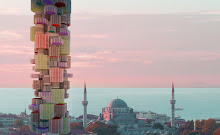Skidmore, Owings and Merrill (SOM), the architects who seem to have perfected the generic glass tower have been awarded a project that is so large and requires such depths of cultural and social sensitivity, diplomacy and skill that I can't help but wonder if their clients knew what they were doing when they hired SOM. Unitech, perhaps India's largest real estate developer commissioned SOM to redesign 124 acres of the Santa Cruz district of Mumbai, which essentially consists of 124 acres of slums housing and 125,000 slum dwellers.
 Slums of Mumbai - Image taken by Simon Bruno
Slums of Mumbai - Image taken by Simon BrunoDesigning an urban environment that equally and adequately addresses the rich and vibrant Indian culture and the unique social structure of slum dwellers is already a tremendous challenge. However, the Santa Cruz redevelopment project is made even tougher because the new apartments for the slum dwellers will be immediately adjacent to high end commercial space - which brings me back to SOM.
From the 1950's to the early 1980's, SOM was undoubtedly a leader in architectural design with buildings like the Lever House in New York (1952), Nation Commercial Bank (1983) and King Abdul Aziz International Airport - Hajj Terminal (1981) in Jeddah and the Sears Tower in Chicago (1974). They popularized the the curtain-wall skyscraper. Their designs were thoughtful and inventive - but no more.
In recent years, their architecture and urban planning have become generic and staid - often regurgitating similar designs. While they continue to push the realm of engineering feats, as with the Burj Dubai, currently the tallest building in the world, local culture and environmental concerns are afterthoughts
 now. Aside from the fact that any building with a glass facade over 164 stories tall has no place in a desert climate, the design of the Burj Dubai is also recycled from a previous design. Likening the plan of the building to some local desert flower after the design was completed was a pathetic attempt to localize the building. The Hong Kong Convention Hall or the the Jin Mao Tower in Shanghai were both supposed to become cultural icons for their cities, however, these buildings have been un-relatable to their local population.
now. Aside from the fact that any building with a glass facade over 164 stories tall has no place in a desert climate, the design of the Burj Dubai is also recycled from a previous design. Likening the plan of the building to some local desert flower after the design was completed was a pathetic attempt to localize the building. The Hong Kong Convention Hall or the the Jin Mao Tower in Shanghai were both supposed to become cultural icons for their cities, however, these buildings have been un-relatable to their local population.Their recent efforts at urban development have been no better either. An entire quadrant of prized historic hutongs, the heart of Beijing's residential neighborhoods were flattened to make room for SOM's design of Finance Street. While SOM thought they were modernizing Beijing, Liang Wei, deputy director of Beijing's Tsinghua Urban Planning and Design Institute viewed it as a "disastrous development," only appropriate perhaps in an empty lot in Nevada.
Now SOM claims that this new design for the slums of Santa Cruz will be reminiscent of Roppongi Hills (Tokyo), Canary Wharf (London) and Battery Park (New York). The choice of these references however, is also unfortunate. Not only did Canary Wharf and Battery Park suffer from minimal success, they also represent what people fear most about globalization - the mindless transplant of the same generic glass towers from city to city devoid of all locality, culture and identity.
The slum dwellers of Santa Cruz will be formidable critics for SOM. For the 125,000 Indian residents, who struggle throughout their lives daily under the harsh and unsafe conditions, I hope SOM succeeds in creating a thoughtful and locally sensitive environment. Who knows, miracles can happen.
*Simon Bruno images were taken from www.simon.bruno.name/india/Day4/index.htm
**The last two pictures are buildings designed by SOM. The first image is the Sears Towers and the second image is the King Abdul Aziz International Airport - Hajj Terminal.































No comments:
Post a Comment